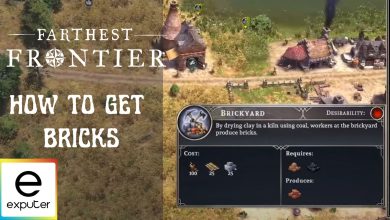Farthest Frontier is a village survival simulation where you need to harvest raw materials, hunt, fish, and farm to survive. While the game offers various mechanics and features to help players enjoy the game, the crop rotation system is a complex one. You need to be fully aware of the crop rotation system to farm in the game. The guide below discusses the Farthest Frontier Best Seeds and how you can farm them.
In Farthest Frontier, you have to grow and farm different items in order to survive. You need to farm the best seed for your crops.
- Different seeds include Turnips, Beans, Peas, Buckwheat, Carrot, Flax, Clover, Leeks, Cabbage, Rye, Wheat, and more.
- Turnip Seeds are recommended for the first farm due to their quick growth and resistance to heat, frost, and disease.
Just like villagers, the crops are also exposed to summer heat waves, low temperatures in winter, and other diseases. Although villagers in the game are hunting for meat or planting fruit trees, you need to do some real farming to make your city thrive. This farming will give more options to provide food to villagers. In this complex system, keeping the soil fertile is one of the major challenges that you will face.
What Are The Best Seeds?
You must wonder what seeds you should plant on your first farm, do not worry, as we have got you covered. You should plant Turnips seed on your farm first, as these are the best seeds to plant on your farm before any other seed.
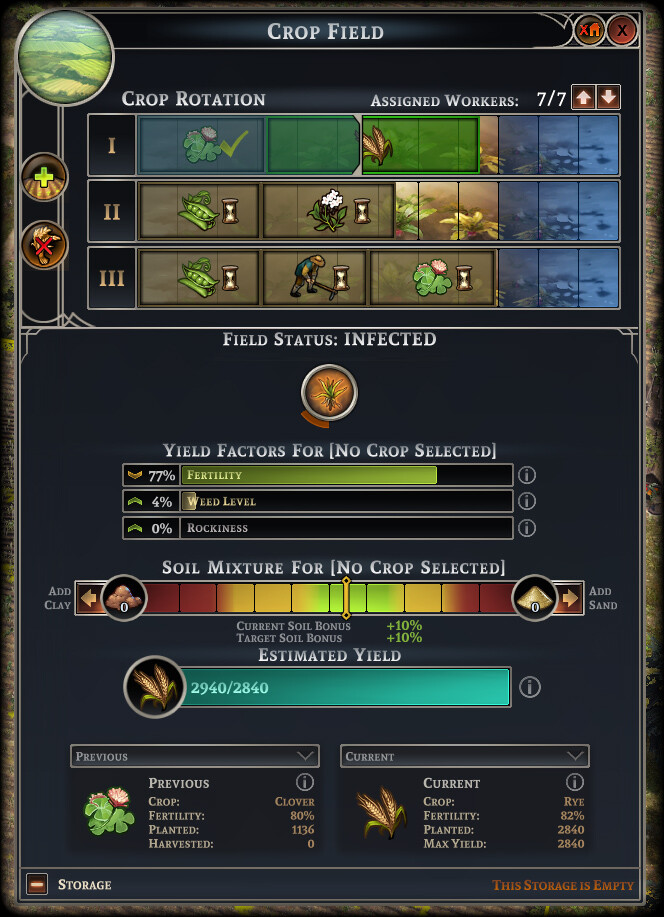
Moreover, the following list ranks the seeds in Farthest Frontier from best to worst.
- Turnips: Fast-growing, multiple harvests per year, heat, frost, and disease resistant.
- Beans: Moderate yield, long storage life, improves soil fertility.
- Peas: Frost tolerant, soil fertility booster, avoid planting in summer due to heat sensitivity.
- Buckwheat: Grain production alternative to wheat, fast growth, weed suppression, thrives in high temperatures.
- Carrots: Frost resistant, storage longevity, requires fertile soil, unsuitable for rocky fields.
- Flax: Used for linen production, soil fertility reducer.
- Clover: Soil fertility enhancer, not for consumption or sale, use in crop rotation.
- Leeks: Long growth period, heat and frost resistant, unsuitable for storage.
- Cabbage: Heat tolerant, requires fertile soil, poor storage capability.
- Rye: Heat and frost tolerant, low soil fertility requirement, lower yield compared to wheat.
- Wheat: Used for beer and flour production, depletes soil fertility, long storage life, high yield in fertile soil.
Before diving into the depth of steps you need to follow to plant the best seeds on your farm, you need to learn the basics of farm creation. We have covered the farm creation in detail for you.
How To Create Farm
Step by step guide on creating a farm:
- Access Food Production Tab: Navigate to the food production tab to find the instrument for farm creation.
- Click, Hold, and Drag: Click, hold, and drag the farm instrument to shape your field. The minimum size should be 5×5, and the maximum size is 12×12. You can adjust existing fields’ sizes from the farm menu.
- Consider Fertility Overlay: As you drag for the field area, observe the fertility overlay displayed on top. The greener the bar, the better the fertility. This helps you make an informed decision about your field’s location.
- Review Field Details: The window will display essential details such as labor hours needed, fertility level, soil mixture, and required number of farmers.
- Wait for Laborers: After placing the field, wait for laborers to finish preparing it. The time taken depends on the field’s size. Work halts during the winter season due to frozen ground.
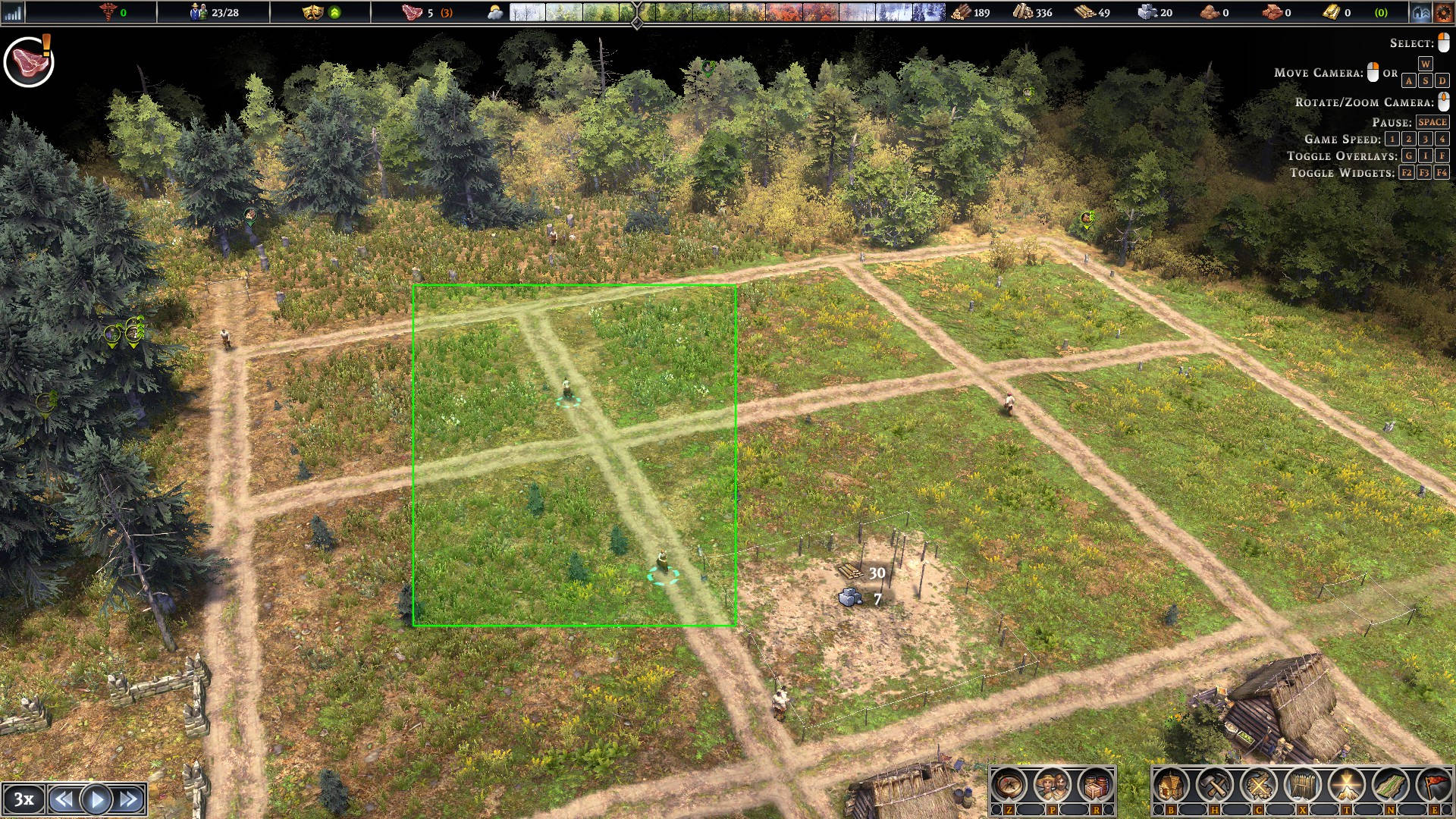
The farming in Farthest Frontier is a bit too complex as compared to other games. We have covered a few terms that will be helpful for you to understand this farming system.
Factors Of Crops
Every crop in Farthest Frontier has eight specific features listed below.
| Crop Yield | The crop you can expect to get |
| Heat Tolerance | The ability of the crop to handle the heat |
| Fertility Dependence | How much a Crop’s success is dependent on good Soil |
| Impacts Fertility | The impact that crop has on soil fertility |
| Frost Tolerance | The ability of crops to handle the cold |
| Grow Time | The time it takes for a crop to grow |
| Weed Suppression | The ability of a crop to grow in the field with weeds |
| Rockiness Resilience | The ability of a crop to grow in the field with rocks |
The heat and frost factors are mostly dependent on the time of the year, while other yield factors can be controlled by you.
How Crop Rotation Works
After your farm is ready, here comes the next step of planting the seeds. It is notified that the farm is ready, and your farmers get instant access to seeds that you want to plant.
However, you need to know that the crop rotation window is a bit too complex. The following guide explains the working of crop rotation.
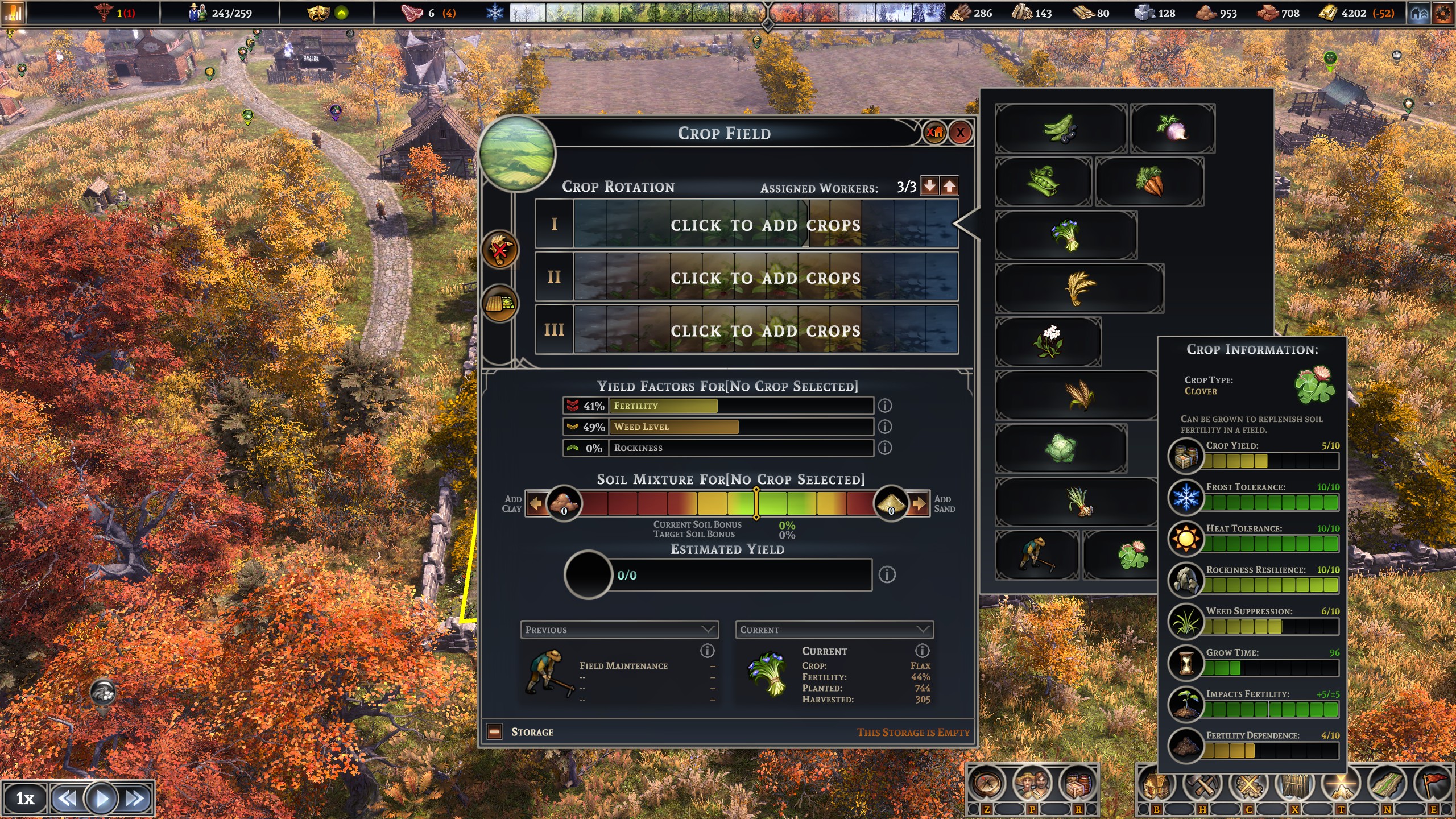
Timeline Of Current Year
You will be able to see three rows numbered Row I, Row II, and Row III. Row I is the representation of the current year, Row II represents the next year, and Row III indicates the year after the next year. A slim line in Row I will be there to indicate the present date and how much the current year has passed. You will also see the factors of your crops under the timeline.
Add A Crop
The next step is to add the crop by selecting the year you want to grow your crop and the crop you want to grow. You can hover over the crop to check its fertility overlay before planting it. We will be planting Turnips first, which is the Farthest Frontier’s best seed. However, you can still check Turnip’s fertility overlay by hovering over it.
After adding the crop, you can change its position on the timeline by dragging it. For example, if a crop has low frost tolerance, try not to farm it close to winter.
You will also see how long a crop takes to grow by seeing how wide the timeline icon is. For turnips, you can either plant the same crop in a timeline or plant some other crop, as Turnips take a shorter time to grow.
Soil Mixture Selection
Once you are done selecting the crop, you will select the soil mixture. You can either add clay or sand to the soil mixture. The meter will also show the amount of mixture needed for the selected crop. After completing all the steps, the three-year cycle will repeat unless you make any changes to it.
How To Improve Soil Fertility
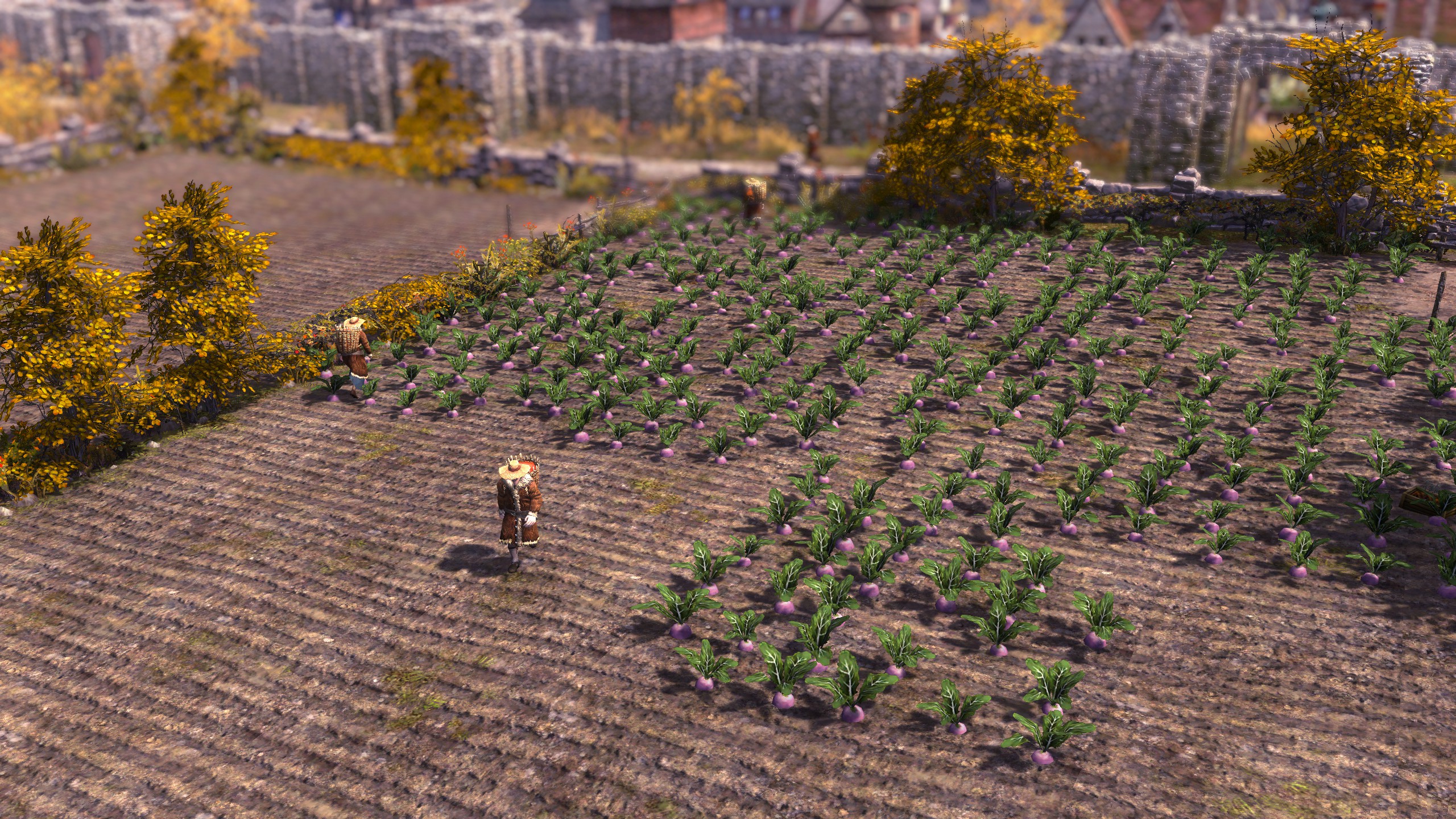
When it comes to farming a seed, the most important factor that comes into action is soil fertility. You can avoid planting seeds that negatively impact soil fertility, such as wheat, rye, and flax. You should grow more of the crops that increase soil fertility, such as clover, beans, and peas. Here are our tips:
- Choose Fertility-Boosting Crops: Opt for crops like clover, beans, and peas that increase soil fertility instead of crops like wheat, rye, and flax that deplete it.
- Rotate Crops: Rotate crops on fields to avoid negative impacts on soil fertility. For instance, alternate planting wheat on different fields every few years to prevent depletion.
- Utilize Compost: Establish a compost yard near your farm to recycle organic waste into nutrient-rich compost. Apply compost to fields with lower fertility levels to replenish nutrients.
How To Take Care Of Crop Factors
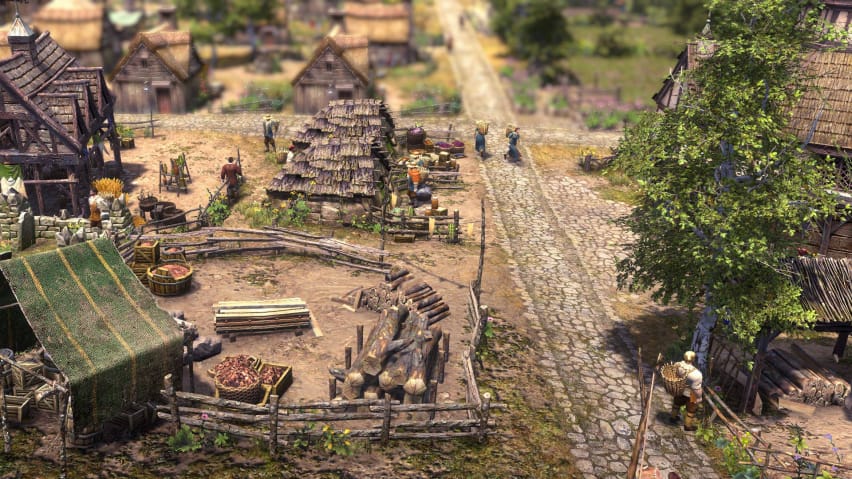
We have already discussed the crop factors associated with each crop in Farthest Frontier. You need to take care of some of these factors to help increase your crop yield. The factors like rockiness level, weed level, fences, walls, and gates are of significant importance.
Moreover, harvest time is another factor that you need to take into consideration while planting. These factors can be managed by following a few simple tips mentioned below.
- Field Maintenance: Assign farmers to practice field maintenance to manage rockiness and weed levels. This will ensure optimal conditions for crop growth and yield.
- Protective Measures: Build fences, walls, and gates around your fields to protect them from wildlife and raids. Upgrade wooden fences to stone walls for enhanced defense.
- Harvest Management: Avoid planting crops with the same harvest time simultaneously to prevent crop spoilage. Prioritize harvesting crops with shorter storage times first to prevent food waste and ensure your villagers are fed.
Conclusion
Crop rotation is the most complex system in Farthest Frontier, and when you prepare to farm by following the steps mentioned in the guide above, you will need to decide what to plant. The best option to plant on your new farm is Turnips, but we have also listed all Farthest Frontier Best Seeds. Soil fertility should also be increased to make farming successful, and it has also been covered in the guide to help you.
Thanks! Do share your feedback with us. ⚡
How can we make this post better? Your help would be appreciated. ✍


